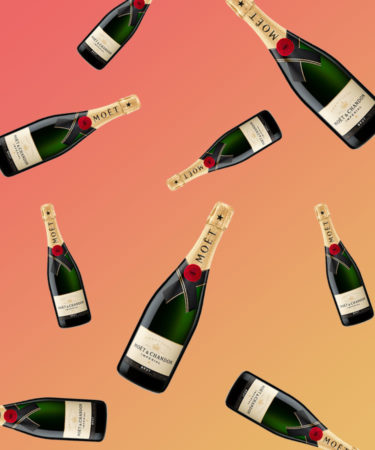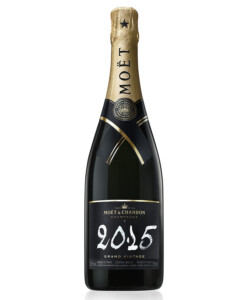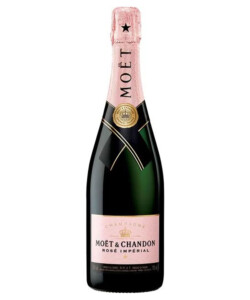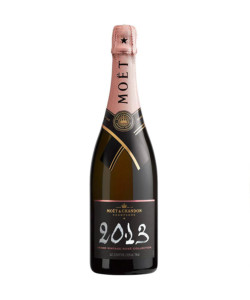Moët & Chandon is easily the biggest name in luxury Champagne,
Rooted in 277 years of French winemaking and marketing ingenuity, the Champagne house is the largest in the world, producing close to 30 million bottles each year. It’s even a celebrity favorite (adored by one very important, very stoic royal). But however popular the brand and bubbly, there are probably a few things you don’t know.
Here are 12 key facts about the famous Champagne house.
-
You’re probably saying it wrong.
Let’s get this out of the way first: It’s pronounced mo-wet, as if a baby is asking you to add more water, “Mo wet, pwease.” People who took French in high school are no doubt mildly devastated by this, considering we’ve all been correcting our friends with the “accurate” French pronunciation. But sorry, the T isn’t silent. The Moët family is originally from the Netherlands, having moved to France in the 1400s, all that time bravely holding onto their family name’s “T” pronunciation in a country notorious for dropping consonant sounds.
-
The Moët name is noble.
In 1445, King Charles VII of France made noblemen of brothers Jean and Nicolas Moët (who, ironically, would’ve probably liked to celebrate with some bubbly). The title carried on to 1743, when their descendent, the wine trader Claude Moët, founded Maison Moët in Épernay, his wine trading territory.
-
Chandon married into the business.
As a brand and a business, Moët & Chandon developed over generations: First there was Claude, then later his grandson Jean-Rémy Moët, who really helped create and globalize the Moët identity. When his son Victor Moët took over in 1832, he was joined by brother-in-law Pierre-Gabriel Chandon de Briailles. The Chandon name later crossed the pond in 1973 when Moët & Chandon established themselves (the first French producer to do so) as Domaine Chandon in the Napa Valley.
-
Moët & Chandon is the powerhouse Champagne.
It’s the largest Champagne house in the world, producing close to 30 million bottles annually, including its signature Moët Impérial, Rosé Impérial, Ice Impérial (more below), Rosé Ice Impérial, and the Grand Vintage Champagnes, which vary from year to year. The signature style, found in the Moët Impérial, is both fruit-forward and elegant: fleshy soft fruit mingling with delicately nutty cereal notes, all tied together in heaven’s own bubble wrap, the Champagne “pearl” carbonation. (In case you’re wondering where they keep all that good stuff, there are more than 17 miles of underground wine cellars at the Moët estate in Épernay.)
-
It’s Queen Elizabeth II’s favorite.
The house of Moët & Chandon is part of the largest luxury conglomerate in the world (wrap your mind around the dollar bill signs in this acronym: LVMH, a.k.a. Louis Vuitton Moët-Hennessy, which formed in the 1980s). So maybe it’s only natural that Moët holds what’s called a “Royal Warrant” to supply Queen Elizabeth with Champagne (which makes you wonder why she isn’t smiling more often). The royal family loves it so much that Moët was actually the Champagne of choice at Charles and Diana’s 1981 wedding.
-
The house also makes Dom Perignon and Hennessy.
Moët & Chandon churns out luxury beverages. They’re the producers of Dom Perignon, officially launching the brand in 1921 as a luxury vintage Champagne. They also make Hennessy Cognac, which they began producing in the 1970s. Dom Perignon is only produced during good vintages and takes a decade-plus to age, which is why the most recent available vintage is the Dom Perignon 2009 (though you’ll have better luck getting the excellent 2008 vintage).
-
Napoleon was an early Moët groupie.
Speaking of “luxury identity,” none other than Napoleon Bonaparte was known to have celebrated his victories with his bubbly of choice, Moët & Chandon. Napoleon supposedly met Jean-Rémy Moët at school as a young man, and the relationship continued over the years, fueled by Napoleon’s habit of stocking up on bubbles before every major military campaign, reasoning that “[i]n victory one deserves it, in defeat one needs it.” Agreed.
-
It’s made with three grapes — and a hundred different wines.
Moët & Chandon’s classic Moët Impérial is made with the traditional trifecta of Champagne grapes: Pinot Noir, Chardonnay, and Pinot Meunier. But that’s not the whole story. Those grapes are gathered from hundreds of parcels (plots of land within a given vineyard) located in hundreds of villages within the limestone-rich Champagne region. So while the components are simple in name — three classic grapes — the assembly of Moët Champagne is a complex process, reflecting a mosaic of terroir.
-
After sourcing the grapes, it’s all about the blend.
Being asked to produce Moët Brut Impérial year after year is like being asked to make exactly the same (delicious, ethereal) cake, with the challenge of getting a pinch of flour from one neighbor, a stick of butter from another, assembling ingredients from sources across an entire region. That’s how Moët is created: not from one vineyard, like a boutique grower Champagne, but from a massive patchwork of vineyards within the Champagne region. The key is blending, whereby a team of producers with highly skilled palates recreates the signature Moët style. It’s an art not uncommon to creating Scotch whisky or Bordeaux red blends.
-
It’s the first Champagne ever to be sprayed after a big win.
Napoleon’s global conquests aside, that is. A Jeroboam of Moët & Chandon was handed to Dan Turney in 1967 after the underestimated driver won the 24-hour Le Mans race in his Ford GT40. It’s not clear whether it was divine inspiration (a whisper from Dom Perignon himself?) but Turney immediately proceeded to open the bottle and spray its contents on himself and the crowd, starting the now-timeless tradition. (And yes, because it’s the future, there’s actually footage of him doing it.)
-
Moët dares to pour Champagne over ice.
If you’re one of the people who like a couple of ice cubes in your white wine, feel shame no longer. (Or, if you’re one of those other people who glare at people who get ice cubes, step on back.) The biggest Champagne house in the world is doing it: In 2010, Moët created its Ice Impérial specifically for pouring over ice cubes, which both dilute the wine’s richer, slightly sweeter fruit elements and loosen its tight chain of bubbles.
-
Moët in the first line of ‘Killer Queen.’
Sure, Moët ’s mentioned in other songs (the Notorious B.I.G. was a big fan, just see what he’s sipping in the back of the club in “Big Poppa”). But Queen’s epic “Killer Queen” starts off with Freddie Mercury singing, “She keeps Moët & Chandon in her pretty cabinet.” If there’s a better pop-culture endorsement, we don’t know what it is.



